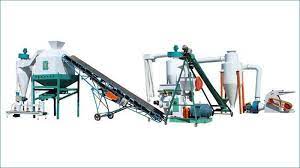
A1 wood pellets are a premium heating fuel known for their efficiency, high energy output, and eco-friendliness. The journey of transforming raw wood into these high-quality pellets involves several meticulous steps. This article delves into the comprehensive production process of A1 wood pellets, from raw wood to the final pellet product.
1. Sourcing the Raw Materials
The production of A1 wood pellets begins with sourcing high-quality raw materials. Typically, these include both softwood and hardwood species such as pine, spruce, fir, oak, maple, and beech. The choice of wood significantly impacts the pellet’s quality, energy content, and burning efficiency.
2. Initial Wood Processing
Once sourced, the raw wood is transported to the processing facility. Here, the wood undergoes an initial processing stage, which includes:
- Debarking: The bark is removed from the logs to ensure the pellets are free from impurities. Bark can produce excessive ash and reduce the pellet’s burning efficiency.
- Chipping: The debarked logs are then fed into a chipper, reducing them into smaller, more manageable wood chips.
3. Drying the Wood Chips
Drying is a crucial step in the production of A1 wood pellets. The moisture content of the wood chips is reduced to around 10%, which is essential for efficient pellet production and combustion. The drying process typically involves:
- Rotary Dryers: The wood chips are passed through large rotary dryers, where they are exposed to hot air. This process effectively reduces their moisture content.
- Monitoring: Constant monitoring ensures the wood chips achieve the desired moisture level, which is critical for producing high-quality pellets.
4. Grinding the Dried Wood
After drying, the wood chips are ground into a fine powder. This step involves the use of hammer mills or other grinding equipment to ensure uniform particle size. The fine consistency of the ground wood is vital for creating dense and durable pellets.
5. Pelletizing the Wood Powder
The finely ground wood powder is then ready for the pelletizing process. This involves:
- Feeding into Pellet Mill: The wood powder is fed into a pellet mill, where it is compressed through a die with small holes.
- Compression and Heat: Under high pressure and temperature, the lignin in the wood acts as a natural binder, helping the particles adhere together to form pellets.
- Shaping and Cutting: As the material is extruded through the die, it forms long strands that are cut into uniform pellet lengths.
6. Cooling the Pellets
Once formed, the pellets are very hot and somewhat soft. They are passed through a cooling system to harden them and stabilize their shape. Cooling also helps to prevent the pellets from sticking together during storage.
7. Screening and Quality Control
The cooled pellets undergo a screening process to remove any fines (small, broken pieces) and ensure uniform size and quality. This step is crucial for maintaining the high standards associated with A1 wood pellets.
8. Packaging the Finished Pellets
After screening, the finished EN plus A1 wood pellets are ready for packaging. They are typically packed in durable, moisture-resistant bags to ensure they remain dry and intact during storage and transportation. Proper packaging is essential to maintain the pellets’ quality until they reach the end consumer.
9. Quality Assurance and Testing
Throughout the production process, rigorous quality control measures are in place. Samples are regularly tested for:
- Moisture Content: Ensuring the pellets meet the standard moisture level.
- Durability: Assessing the hardness and resistance to breaking.
- Ash Content: Verifying low ash content for clean burning.
- Energy Content: Measuring the calorific value to ensure high energy output.
To conclude, the production process of A1 wood pellets is a detailed and precise operation that transforms raw wood into a high-quality, efficient heating fuel. From sourcing the best raw materials to the final packaging, each step is meticulously executed to produce pellets that meet stringent standards of quality and performance. By understanding the production process, consumers can appreciate the care and expertise involved in making Enplus A1 wood pellets, ensuring they receive a product that delivers excellent heating efficiency and environmental benefits. Continue ready our guide to biomass pellets by following the link behind